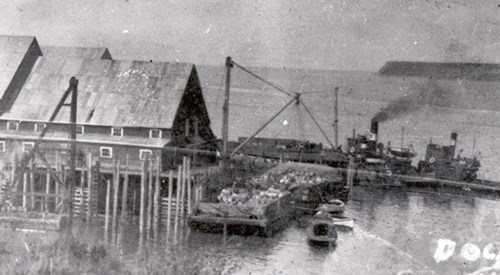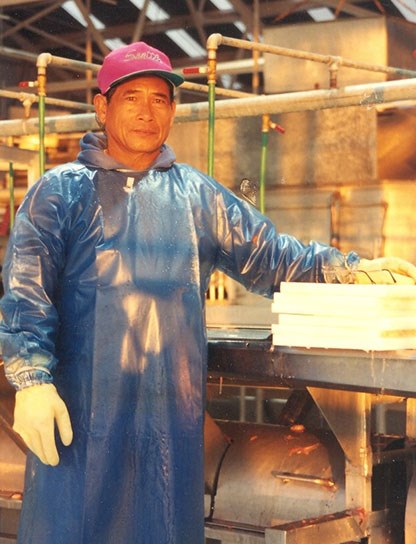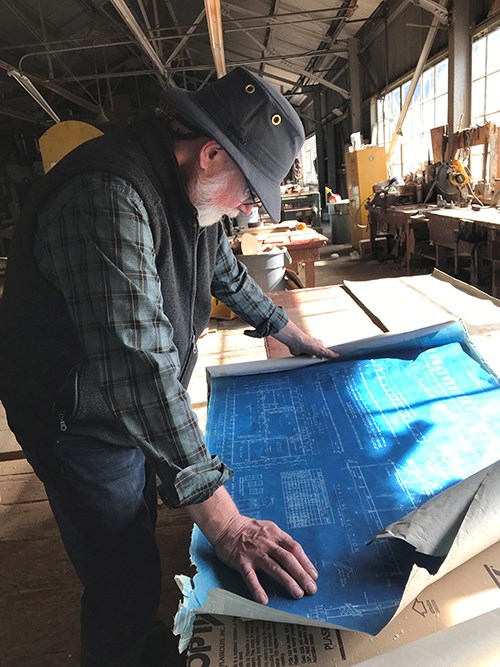Part of a series of articles titled Canneries of Alaska.
Previous: Canneries of Alaska
Article
The Alaska Packers Association started the Diamond NN <NN> Cannery after it absorbed a small saltery built in 1890 on the southside of the Naknek River, adjacent to a small creek. Now owned by Trident Seafoods, the cannery operated continuously for the next 106 years, with the exception of two years during World War II. Today, the site is a little more than 238 acres and is comprised of 53 buildings and structures that contribute to the significance of the proposed NN Cannery Maritime Historic District.
NN Cannery Building


Left image
The NN Cannery Building, ca. 1950
Credit: APA Collection, Record 609, Center for Pacific Northwest Studies, Bellingham, WA
Right image
The former NN Cannery building as seen in 2016.
Credit: Courtesy of Bob King, NN Cannery History Project

APA Collection, San Francisco Maritime National Historic Park
Typical of a cannery, each building was constructed and used for a unique purpose. The original structures constructed for production included the cannery building, boiler room, a machine shop, carpenter shop, blacksmith shop, beach locker, salmon storage, warehouse, and a dock. The cannery had a graveyard, which was integrated. Both Chinese and Euroamericans were buried there. Ancillary buildings included the office, the foreman’s house, the superintendent's house, hospital, and hotel for guests. Prior to 1979, the cannery was segregated with an Italian bunkhouse, Scandinavian bunkhouse, Filipino bunkhouse, women’s bunkhouse, a machinist bunkhouse for the white, skilled workers, and -- in the early years -- a designated area for the Chinese workers referred to as “Chinatown.” Chinatown would later become the housing area for the historically underrepresented Mexican workers.
At one time, the cannery supported three different mess halls, with one for white workers and another for the ethnically diverse cannery crew. The Native village of South Naknek developed adjacent to the cannery and included a Russian Orthodox Church and graveyard. The cannery supported the surrounding communities as well, as demonstrated during the Spanish Flu Pandemic of 1918, when the hospital took on Native patients and opened a temporary orphanage.
The cannery complex functioned as a small university that operated during the summer season. The majority of the cannery workers were single and lived outside of Alaska. The mess halls fed a combined 500 to 600 people a day and served four meals: breakfast, lunch, dinner, and a midnight meal, as well as three "mug-ups." Mug-ups, specific to the cannery culture, are coffee breaks that gave the cannery crew a reprieve from the slime line and patching table for a brief 15 minutes. In addition to fresh doughnuts and the smell of salmon, salt, and cigarette smoke, one could often hear ten different languages on the dock at mug-up.

Courtesy of Katherine Ringsmuth, NN Cannery History Project.
During the first years of operation, the workforce consisted of Italian and Scandinavian fisherman who caught the salmon in sailboats, and Chinese workers who completed almost the entire canning process. The Chinese butchered and slimed the fish and soldered the cans. A work line typically consisted of four butchers and five slimers, producing three fish per minute. In 1882, the United States passed the Chinese Exclusion Act, restricting Chinese immigration into the country. This led to a decrease in skilled Chinese labor forcing the salmon canning industry to seek other alternatives in the production process.
In 1905, the Smith Butchering Machine, often referred to as the "Iron Chink," was introduced to Alaskan salmon canneries. This machine increased fish production to 60-75 fish per minute while only requiring three laborers. After the Chinese Exclusion Act, the cannery workforce diversified and consisted of Puerto Ricans, Koreans, Japanese, and predominantly Mexican cannery workers. With the rise of unionization in the 1930s, Filipino workers ultimately became the backbone of the cannery crew until the arrival of women and college students in the 1980s.

Courtesy of Katherine Ringsmuth, NN Cannery History Project
Interview with Katherine Ringsmuth. February 12, 2019.
Ringsmuth, Katherine. NN Cannery Maritime Historic District. Naknek, Bristol Bay, Alaska. Draft National Register of Historic Places Nomination. 2019.
Part of a series of articles titled Canneries of Alaska.
Previous: Canneries of Alaska
Last updated: November 5, 2019